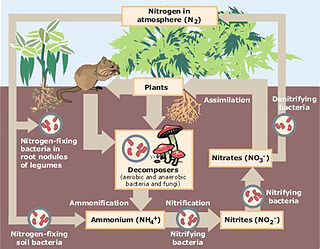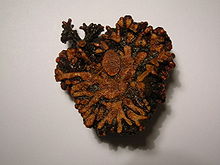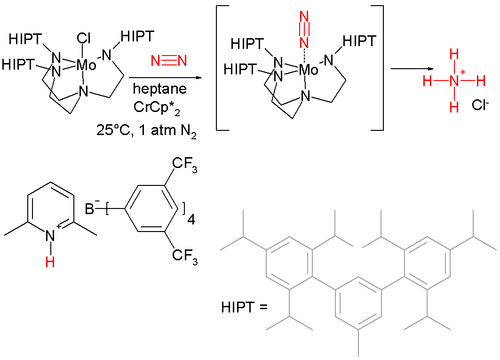- Nitrogen fixation
-
Nitrogen fixation is the natural process, either biological or abiotic, by which nitrogen (N2) in the atmosphere is converted into ammonia (NH3).[1] This process is essential for life because fixed nitrogen is required to biosynthesize the basic building blocks of life, e.g., nucleotides for DNA and RNA and amino acids for proteins. Nitrogen fixation also refers to other biological conversions of nitrogen, such as its conversion to nitrogen dioxide.
Microorganisms that fix nitrogen are bacteria called diazotrophs. Some higher plants, and some animals (termites), have formed associations (symbioses) with diazotrophs. Nitrogen fixation also occurs as a result of non-biological processes. These include lightning, industrially through the Haber-Bosch Process, and combustion.[2] Biological nitrogen fixation was discovered by the German agronomist Hermann Hellriegel and Dutch microbiologist Martinus Beijerinck.
Contents
Biological nitrogen fixation
Biological nitrogen fixation (BNF) occurs when atmospheric nitrogen is converted to ammonia by an enzyme called nitrogenase.[1] The reaction for BNF is:
- N2 + 8 H+ + 8 e− → 2 NH3 + H2
The process is coupled to the hydrolysis of 16 equivalents of ATP and is accompanied by the co-formation of one molecule of H2. In free-living diazotrophs, the nitrogenase-generated ammonium is assimilated into glutamate through the glutamine synthetase/glutamate synthase pathway.
Enzymes responsible for nitrogenase action are very susceptible to destruction by oxygen. (In fact, many bacteria cease production of the enzyme in the presence of oxygen).[1] Many nitrogen-fixing organisms exist only in anaerobic conditions, respiring to draw down oxygen levels, or binding the oxygen with a protein such as Leghemoglobin.[1]
Microorganisms that fix nitrogen (diazotrophs)
Nitrogen fixation by rhizobia and frankia
Rhizobia are Gram-negative soil bacteria with the ability to establish a N2-fixing symbiosis on legume roots and on the stems of some aquatic legumes. During this interaction bacteroids, as rhizobia are called in the symbiotic state, are contained in intracellular compartments within a specialized organ, the nodule, where they fix N2. Similarly, Frankia, Gram-positive soil bacteria induce the formation of nitrogen-fixing nodules in actinorhizal plants. [3]
Nitrogen fixation by cyanobacteria
Cyanobacteria inhabit nearly all illuminated environments on Earth and play key roles in the carbon and nitrogen cycle of the biosphere. In general, cyanobacteria are able to utilize a variety of inorganic and organic sources of combined nitrogen, like nitrate, nitrite, ammonium, urea, or some amino acids. Several cyanobacterial strains are also capable of diazotrophic growth. Genome sequencing has provided a large amount of information on the genetic basis of nitrogen metabolism and its control in different cyanobacteria. Comparative genomics, together with functional studies, has led to a significant advance in this field over the past years. 2-Oxoglutarate has turned out to be the central signalling molecule reflecting the carbon/nitrogen balance of cyanobacteria. Central players of nitrogen control are the global transcriptional factor NtcA, which controls the expression of many genes involved in nitrogen metabolism, as well as the PII signalling protein, which fine-tunes cellular activities in response to changing C/N conditions. These two proteins are sensors of the cellular 2-oxoglutarate level and have been conserved in all cyanobacteria. In contrast, the adaptation to nitrogen starvation involves heterogeneous responses in different strains.[4] Nitrogen fixation by cyanobacteria in coral reefs can fix twice the amount of nitrogen than on land–around 1.8 kg of nitrogen is fixed per hectare per day.
Root nodule symbioses
Legume family
Plants that contribute to nitrogen fixation include the legume family – Fabaceae – with taxa such as clovers, soybeans, alfalfa, lupines, peanuts, and rooibos. They contain symbiotic bacteria called Rhizobia within nodules in their root systems, producing nitrogen compounds that help the plant to grow and compete with other plants. When the plant dies, the fixed nitrogen is released, making it available to other plants and this helps to fertilize the soil[1][5] The great majority of legumes have this association, but a few genera (e.g., Styphnolobium) do not. In many traditional and organic farming practices, fields are rotated through various types of crops, which usually includes one consisting mainly or entirely of clover or buckwheat (family Polygonaceae), which are often referred to as "green manure."
Inga alley farming relies on the leguminous genus,Inga a small tropical, tough-leaved, nitrogen-fixing tree.[6]
Non-leguminous
Although by far the majority plants able to form nitrogen-fixing root nodules are in the legume family Fabaceae, there are a few exceptions:
- Parasponia, a tropical Celtidaceae also able to interact with rhizobia and form nitrogen-fixing nodules[7]
- Actinorhizal plants such as alder and bayberry, that can also forms nitrogen-fixing nodules, thanks to a symbiotic association with Frankia bacteria. These plants belong to 25 genera[8] distributed among 8 plant families. The ability to fix nitrogen is far from universally present in these families. For instance, of 122 genus in the Rosaceae, only 4 genera are capable of fixing nitrogen. All these families belong to the orders Cucurbitales, Fagales, and Rosales, which together with the Fabales form a clade of eurosids. In this clade, Fabales were the first lineage to branch off; thus, the ability to fix nitrogen may be plesiomorphic and subsequently lost in most descendants of the original nitrogen-fixing plant; however, it may be that the basic genetic and physiological requirements were present in an incipient state in the last common ancestors of all these plants, but only evolved to full function in some of them:
Family: Genera Betulaceae: Alnus (alders)
- Allocasuarina
- Casuarina
- Ceuthostoma
- Gymnostoma
......
Coriariaceae: Coriaria- Elaeagnus (silverberries)
- Hippophae (sea-buckthorns)
- Shepherdia (buffaloberries)
......
......
......
- Cercocarpus (mountain mahoganies)
- Chamaebatia (mountain miseries)
- Dryas
- Purshia/Cowania (bitterbrushes/cliffroses)
There are also several nitrogen-fixing symbiotic associations that involve cyanobacteria (such as Nostoc):
Chemical nitrogen fixation
Haber process
Nitrogen can also be artificially fixed as ammonia for use in fertilizers, explosives, or in other products. The most common method is the Haber process. Artificial fertilizer production is now the largest source of human-produced fixed nitrogen in the Earth's ecosystem.[9]
The Haber process requires high pressures (around 200 atm) and high temperatures (at least 400 °C), routine conditions for industrial catalysis. This highly efficient process uses natural gas as a hydrogen source and air as a nitrogen source.
Dinitrogen complexes
Much research has been conducted on the discovery of catalysts for nitrogen fixation, often with the goal of reducing the energy required for this conversion. However, such research has thus far failed to even approach the efficiency and ease of the Haber process. Many compounds react with atmospheric nitrogen under ambient conditions. For example, lithium metal converts to lithium nitride under an atmosphere of nitrogen. Treatment of the resulting nitride gives ammonia.
The first dinitrogen complex was reported in 1965 based on ammonia coordinated to ruthenium ([Ru(NH3)5(N2)]2+).[10] Research in chemical fixation from then on focused on transition metal complexes. Since then, a large number of transition metal compounds that contain dinitrogen as a ligand have been discovered. The dinitrogen ligand can either be bound to a single metal or bridge two (or more) metals. The coordination chemistry of dinitrogen is complex and currently under intense investigation. This research may lead to new ways of using dinitrogen in synthesis and on an industrial scale.
Ambient nitrogen reduction
Catalytic chemical nitrogen fixation at temperatures considerably lower than the Haber process is an ongoing scientific endeavor. Nitrogen was successfully converted to ammonia and hydrazine by Alexander E. Shilov in 1970.[11][12] The first example of homolytic cleavage of dinitrogen under mild conditions was published in 1995. Two equivalents of a molybdenum complex reacted with one equivalent of dinitrogen, creating a triple bonded MoN complex.[13] Since then, this triple bounded complex has been used to make nitriles.[14]
The first catalytic system converting nitrogen to ammonia at room temperature and pressure was discovered in 2003 and is based on another molybdenum compound, a proton source, and a strong reducing agent.[15][16][17][18] However, this catalytic reduction fixates only a few nitrogen molecules.
In 2011 Arashiba et al. reported another system with a catalyst again based on molybdenum but with a diphosphorus pincer ligand.[19]
See also
- Birkeland–Eyde process
- Haber process
- Denitrification
- George Washington Carver
- Nif gene
- Nitrification
- Nitrogen cycle
- Nitrogen deficiency
- Nitrogenase
- Push–pull technology
References
- ^ a b c d e Postgate, J (1998). Nitrogen Fixation, 3rd Edition. Cambridge University Press, Cambridge UK.
- ^ http://helios.bto.ed.ac.uk/bto/microbes/nitrogen.htm
- ^ Moir, JWB (editor) (2011). Nitrogen cycling in bacteria: Molecular analysis. Caister Academic Press. ISBN 978-1-904455-86-8.
- ^ Herrero A and Flores E (editor). (2008). The Cyanobacteria: Molecular Biology, Genomics and Evolution (1st ed.). Caister Academic Press. ISBN 978-1-904455-15-8. [1]. http://www.horizonpress.com/cyan.
- ^ Smil, V (2000). Cycles of Life. Scientific American Library.
- ^ Elkan, Daniel. Slash-and-burn farming has become a major threat to the world's rainforest The Guardian 21 April 2004
- ^ Op den Camp, Rik; et al.. "LysM-Type Mycorrhizal Receptor Recruited for Rhizobium Symbiosis in Nonlegume Parasponia". Science 331 (6019): 909–912. doi:10.1126/science.1198181.
- ^ Dawson, J. O. (2008). "Ecology of actinorhizal plants". Nitrogen-fixing Actinorhizal Symbioses. 6. Springer. pp. 199–234. doi:10.1007/978-1-4020-3547-0_8.
- ^ http://www.epa.gov/watertrain/nitroabstr.html US Enivronmental Protection Agency: Human Alteration of the Global Nitrogen Cycle: Causes and Consequences by Peter M. Vitousek, Chair, John Aber, Robert W. Howarth, Gene E. Likens, Pamela A. Matson, David W. Schindler, William H. Schlesinger, and G. David Tilman
- ^ A. D. Allen, C. V. Senoff (1965). "Nitrogenopentammineruthenium(II) complexes". Journal of the Chemical Society, Chemical Communications (24): 621. doi:10.1039/C19650000621.
- ^ Catalytic reduction of molecular nitrogen in solutions A.E. Shilov Russian Chemical Bulletin Volume 52, Number 12, 2555-2562, doi:10.1023/B:RUCB.0000019873.81002.60
- ^ Reduction of dinitrogen Richard R. Schrock PNAS November 14, 2006 vol. 103 no. 46 17087 doi:10.1073/pnas.0603633103
- ^ Dinitrogen Cleavage by a Three-Coordinate Molybdenum(III) Complex Catalina E. Laplaza and Christopher C. Cummins Science 12 May 1995: 861-863.10.1126/science.268.5212.861
- ^ A Cycle for Organic Nitrile Synthesis via Dinitrogen Cleavage John J. Curley, Emma L. Sceats, and Christopher C. Cummins J. Am. Chem. Soc., 2006, 128 (43), pp 14036–14037 doi:10.1021/ja066090a
- ^ Synthesis and Reactions of Molybdenum Triamidoamine Complexes Containing Hexaisopropylterphenyl Substituents Dmitry V. Yandulov, Richard R. Schrock, Arnold L. Rheingold, Christopher Ceccarelli, and William M. Davis Inorg. Chem.; 2003; 42(3) pp 796–813; (Article) doi:10.1021/ic020505l
- ^ Catalytic Reduction of Dinitrogen to Ammonia at a Single Molybdenum Center Dmitry V. Yandulov and Richard R. Schrock Science 4 July 2003: Vol. 301. no. 5629, pp. 76–78 doi:10.1126/science.1085326
- ^ The catalyst is based on molybdenum(V) chloride and tris(2-aminoethyl)amine substituted with three very bulky hexa-isopropylterphenyl (HIPT) groups. Nitrogen adds end-on to the molybdenum atom, and the bulky HIPT substituents prevent the formation of the stable and nonreactive Mo-N=N-Mo dimer, and the nitrogen is reduced in an isolated pocket. The proton donor is a pyridinium cation, which is accompanied by a tetraborate counter ion. The reducing agent is decamethylchromocene. All ammonia formed is collected as the HCl salt by trapping the distillate with a HCl solution
- ^ Note also that, although the dinitrogen complex is shown in brackets, this species can be isolated and characterized. Here the brackets do not indicate that the intermediate is not observed.
- ^ A molybdenum complex bearing PNP-type pincer ligands leads to the catalytic reduction of dinitrogen into ammonia Kazuya Arashiba, Yoshihiro Miyake Yoshiaki Nishibayashi Nature Chemistry Volume: 3, Pages: 120–125 Year published:(2011 doi:10.1038/nchem.906
External links
Categories:- Nitrogen metabolism
- Metabolism
- Plant physiology
- Soil biology
- Microbiology
Wikimedia Foundation. 2010.




